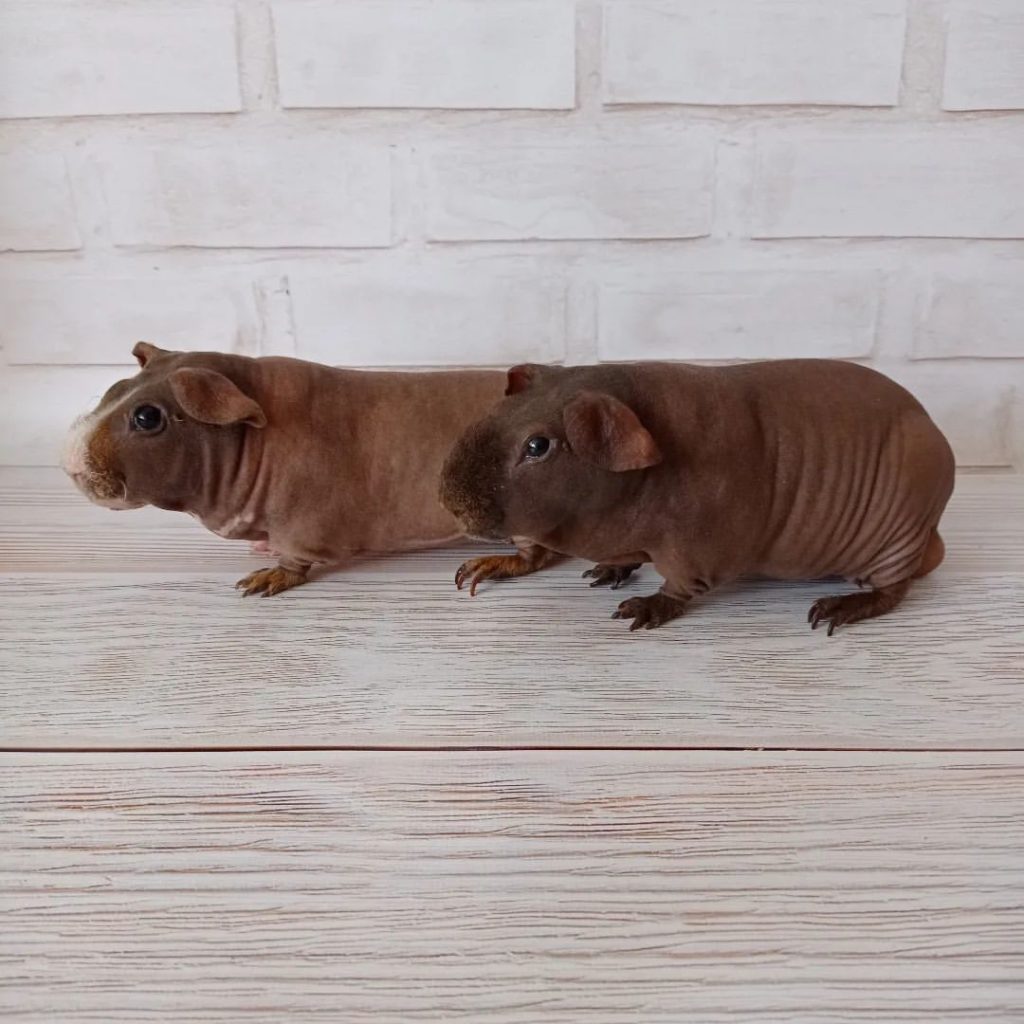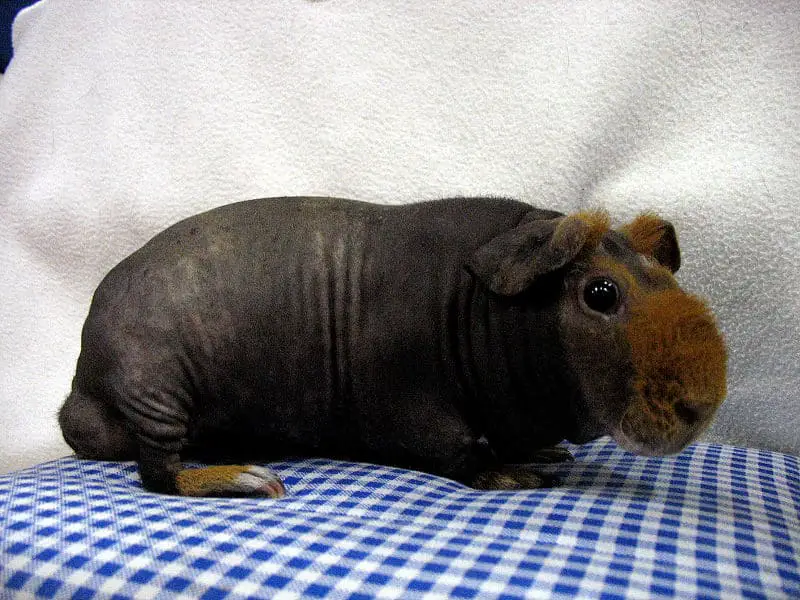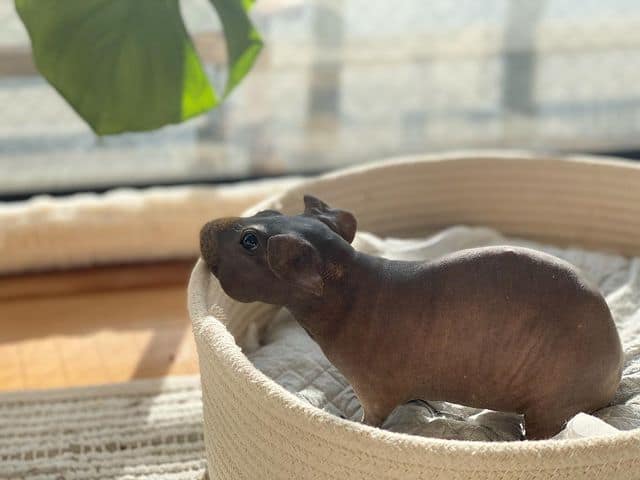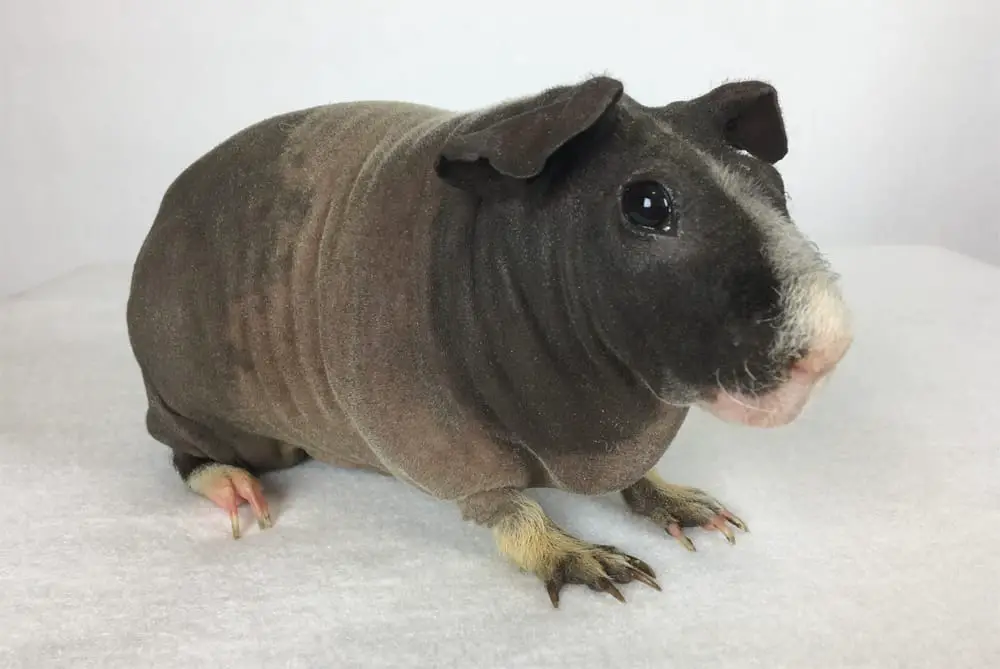If you think only fluffy animals make great pets, it is because you have not yet met a Skinny Pig—an almost hairless guinea pig variety that makes sweet, social, and affectionate pets. They are not too different from the fluffy guinea pigs that we all know and love, except that they do not have hair except for a little fuzz on their feet, muzzles, and sometimes on the back. Being hairless with the same vibrant personality as regular guinea pigs make Skinny Pigs great pets for those who have allergies.
Despite the “skinny” part in their name, these hairless cavies are chubby little things. A healthy Skinny Pig has a full body with no ribs or bones showing. Their skins are smooth and have some wrinkling in places where the skin folds such as around the neck and their paws.
So, if you did not figure it out yet, “skinny” does not mean that they are too thin! It just means that you can see more “skin” in them due to being hairless.
Another cool fact about Skinny Pigs is that if one has more hair than usual, they are called “werewolves”. A werewolf usually has visible hair on its back down to the rump.
Now, let us have a more in-depth look at this adorable guinea pig variety that proves “bald” is, in fact, beautiful!
Skinny Pig Fact Sheet
| Names | Skinny Pig, Hairless Guinea Pig |
| Weight | Typically between 1 and 2 pounds |
| Size | 9 to 12 inches in length |
| Diet | Herbivorous, mostly hay, smaller amounts of pellets, fruits & vegetables |
| Lifespan | 4 to 8 years |
| Coat | Bald with small tufts of hair |
| Colors | Many, including black, brown, gray, cinnamon, and pink |
| Temperament | Social, affectionate, initially shy |
| Experience required | Beginner-friendly |
| Price | Upwards of $150 |
History of the Skinny Pig
In 1978, Armand Frappier Institute in Montreal observed hairless guinea pigs in a colony of Hartley lab guinea pigs. It was a result of a spontaneous genetic mutation. Therefore, while regular guinea pigs, who are natives of Peru, have a history of thousands of years, Hairless Guinea Pigs have been around for only about 40 years. With several decades of careful breeding, however, Skinny Pigs have grown to become a healthy and strong breed.
A few years later from the initial discovery in Montreal, Charles River Laboratories in the US started breeding Skinny Pigs as a cross between the haired ones and the genetic mutation. Due to the skin of guinea pigs being similar to humans, these hairless guinea pigs started being highly useful in dermatology studies.
There is another hairless guinea pig variety called “Baldwin guinea pig”, which is different from a Skinny Pig. The recessive gene that causes hairlessness is different in the two varieties. From the late 90s to the present, Skinny Pigs have started becoming a popular pet choice due to their unique looks and also their sociable nature.
Personality and Temperament
- Affectionate
- Chatty
- Social
- Initially shy
Skinny Pigs are highly affectionate pets. They have the ability to quickly distinguish the voice and the presence of their owner, and would visibly show their joy when the owner is around. They even make a quiet vibrating sound when they are happy and comfortable, just like when cats purr. If you take time to properly bond with them, they will allow you to cuddle and pet them as well.
However, it is important not to chase them or forcefully pet their bodies. A little scratch behind their ears or a gentle pat on their back, once they are familiar with you, is usually okay. The level of touch or contact that each individual Skinny Pig is comfortable with can be different from one another. You have to be patient and gently take the time needed to get to know your pet and see what they like.
The temperament and the behavioral patterns of Skinny Pigs are almost identical to regular guinea pigs. Even though they may seem shy at first, they grow bold and vibrant personalities as they become familiar and comfortable with their habitat. They are also quite chatty little creatures. They make tiny but distinct noises and squeaks depending on what or how they feel. If you have more than two Skinny Pigs, you may notice a difference in sounds as a way of maintaining the social rank amongst them.

Due to their strong and social nature, Skinny Pigs make good pets for children above elementary school age. However, since they are little prey animals, it is better to keep them away from larger pets with prey instincts such as cats and dogs. They will, however, get along well with other guinea pigs. Since Skinny Pigs are social animals, it is always better to keep more than one of them in a habitat for a sense of companionship. Depending on the space you have for their habitat, get at least two Skinny Pigs who get along well with each other.
Appearance of the Skinny Pig

No two Skinny Pigs are ever the same. Even if they share the same colors, there will always be something unique like a little tuft of hair on their muzzle or left paw, making your own cavy as unique as it can be. Other distinctly adorable features in these guinea pig varieties include their skin folds or wrinkles and their drooping ears (Think of a very tiny hippo!).
It is the uniquely strange appearance that makes Skinny Pigs highly desired and adored by pet enthusiasts. Just like guinea pig breeds with hair, these hairless cavies also come in a variety of colors including black, brown, gray, cinnamon, pink, and combinations of those colors. The patterns on their skin sometimes mimic hair, but most healthy skinny pigs are almost entirely hairless.
Fun Fact: Due to their lack of fluffy coats, Skinny Pigs constantly look for warmth. This means, you can dress them up in clothes and they will be happy to feel cozy and look absolutely cute in a funny little costume you make for them—which is something not a lot of pets appreciate!
Feeding a Skinny Pig 🍎
- 80% high-quality hay ✔️
- Pellets fortified with vitamin C ✔️
- Fresh fruits and vegetables such as leafy greens, carrots, zucchini, kiwi ✔️
- The occasional treat ✔️
Skinny Pigs love to indulge in a good meal. Since they do not have a coat to keep them, they compensate for it by eating more to maintain their body heat. Their fast metabolism keeps them healthy even though they usually consume quite a bit more food than the haired guinea pigs. They do not pick and choose, not to worry, even if you are not all that good in the kitchen, they will appreciate what you feed them!
About 80% of their diet consists of high-quality hay. The rest includes fresh produce and fortified pellet food. A healthy Skinny Pig usually eats about ⅙ cup of pellets at a time, which is slightly more than a hairy guinea pig. If you are getting commercial food, look for food that is fortified with vitamin C.
Other than that, you can give them generous amounts of timothy hay and fresh vegetables, similar to the diet of regular guinea pigs, but with somewhat larger amounts. Guinea pigs are herbivores, so avoid giving them meat since they cannot properly digest it.
Add plenty of leafy greens to the diet and crunch vegetables such as carrots and zucchini as healthy snacks. Try to provide a variety of fresh fruit and vegetables at least once a day. If the fruits are high in sugar, keep the portions small and give them as an occasional treat. Vitamin C-dense food varieties such as kiwis and citrus fruit make great treats for Skinny Pigs. You can also mix in some rolled oats with the hay for an extra treat.
Just like all guinea pig breeds, Skinny Pigs are prone to developing bladder stones that are composed of calcium oxalate. Therefore, be careful to avoid food with high oxalate content such as spinach and parsley.
Health and Care

The lifespan of Skinny Pigs is not too different than their haired cousins. On average, they live between 4 and 8 years, which is similar to other breeds. With great care and genetics, some may even live up to 10 years.
However, the exposed skin of hairless cavies is quite vulnerable to sunburn, injuries, and skin infections if necessary precautions are not taken. You need to make sure that there are no wood chippings or sharp edges in their habitat that can break their skin, for example.
Also, if you are taking your Skinny Pig outside in the sunlight for extended periods of time, it is important that you use mild sunscreen on the skin. You should also cover the pet to make sure they do not get too much direct sun exposure, which can lead to painful sunburns.
You do not need to brush Skinny Pigs and bathtime is also pretty straightforward due to their skin. Use a very mild shampoo that is emulsified well with water to get any visible dirt off their skin. Make sure that you’re not too rough with their delicate skin.
Once the bathtime is over, softly pat them dry with a towel and get them back to their clean habitat. Avoid using hair dryers since they can excessively dry out the natural moisture and oils in their skin.
Housing a Skinny Pig 🏘️
As mentioned above, you need to prioritize the safety of the Skinny Pig’s skin when you set up their habitat. They are active and social creatures, which means you need to have at least 8 square feet of space per animal.
Some of the smaller-sized guinea pig cages that you can utilize vertical space to increase living area. However, Skinny Pigs do not climb, jump, or are particularly interested in exploring vertical spaces. They need plenty of floor space and a few ramps and platforms on the floor for some excitement and variety as they explore.
You can house both hairless guinea pigs and regular guinea pigs in the same habitat with no issue. However, you need to have plenty of horizontal space for them to explore and feel safe. A tank or a habitat that is about twice as wide as it is tall is a good rule of thumb when you are setting up their habitat.
You can also improve their time in larger horizontal spaces by taking them out of their habitat to a safe and enclosed space and keeping an eye while they enjoy exploring around.
Bedding is an extremely important aspect of a good Skinny Pig cage or a habitat. Include plenty of lining such as paper shavings and soft bedding like fleece in their habitat to avoid accidental bruises or scratches.
While wood shavings are a popular lining choice for regular guinea pigs, it is better to avoid them with Hairless guinea pigs due to their sensitive skin. Moreover, wood shavings such as cedar and pine have chemicals that can cause harm if they are ingested.
The temperature of the habitat should be maintained at around 65° and 75°F. Make sure it does not get direct sunlight, heat from a fireplace, or a vent that can influence the temperature in extreme ways. However, the habitat should be in a place where they can get sufficient mild sunlight during the day. You do not need to manipulate their light exposure in any way since they are not nocturnal or highly light-sensitive animals.
They should have access to clean water at all times. Use a ceramic bowl instead of plastic or paper since they tend to try and chew through light materials.
Buying a Skinny Pig
Due to the popularity of the breed and the special care needed in breeding, Skinny Pigs often cost upward of $150 from a reputable breeder. Before you buy your cavy, make sure that they are the right breed and not a different hairless guinea pig variety.
A skinny pig usually has tufts of hair around its nose and feet and they are born the same way. The Baldwin guinea pig, on the other hand, is born with a full coat of hair, but around two months of age, they become fully hairless.
Also, while guinea pigs should not be kept in solitude, it’s not necessary to buy two hairless cavies. They get along just fine with furry guinea pig breeds!
Final words
Just like any other pet, owning a Skinny Pig and getting to enjoy their amazing personality and companionship is both a high responsibility and privilege. Therefore, learning as much as possible about them and making sure they have a safe and pleasant habitat to spend their life is important before you get them.
Skinny pigs are great for first-time pet owners as well as people with more experience. Their affectionate, social, and intelligent personality combined with their unique and interesting appearance makes them a great fit for many households.
If the Hairless Guinea Pig is not your cup of tea, perhaps you’re more interested in a fluffier breed such as these:
- How Long Do American Eskimo Dogs Live? Important Factors and Care Tips - September 29, 2023
- Do American Bulldogs Need Grooming? Essential Tips and Care Guidelines - September 29, 2023
- Do Bengal Cats Enjoy Playing? Essential Tips for Keeping Them Active - September 29, 2023
